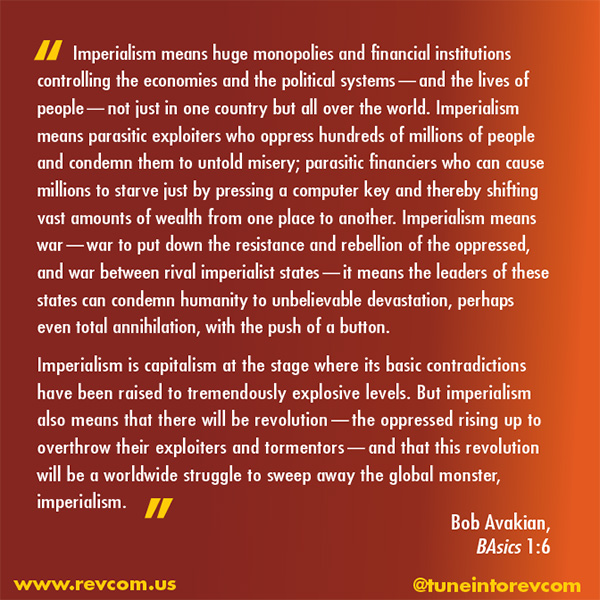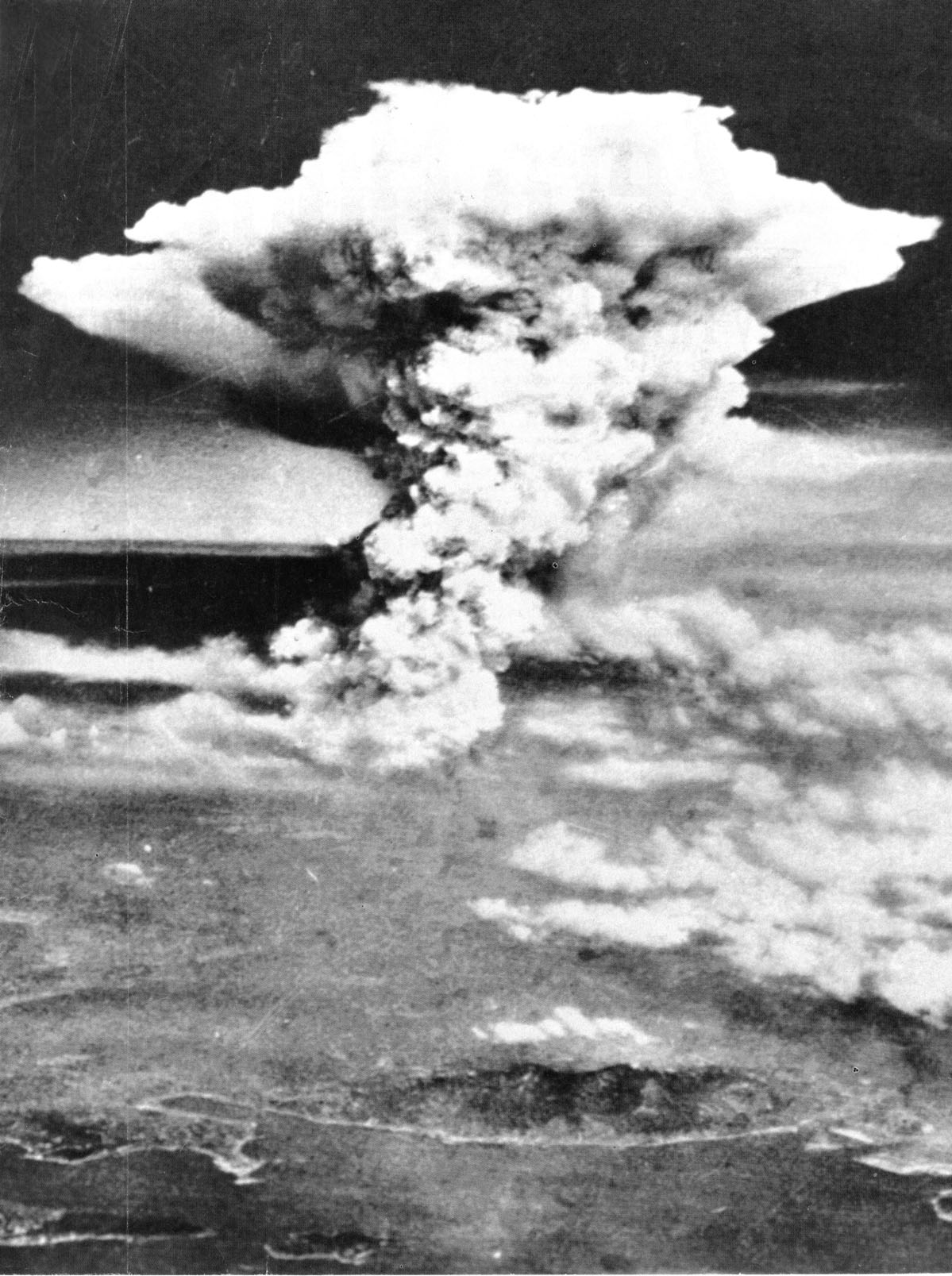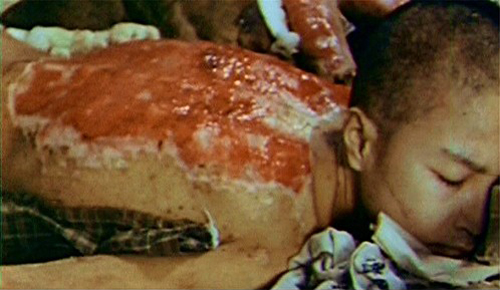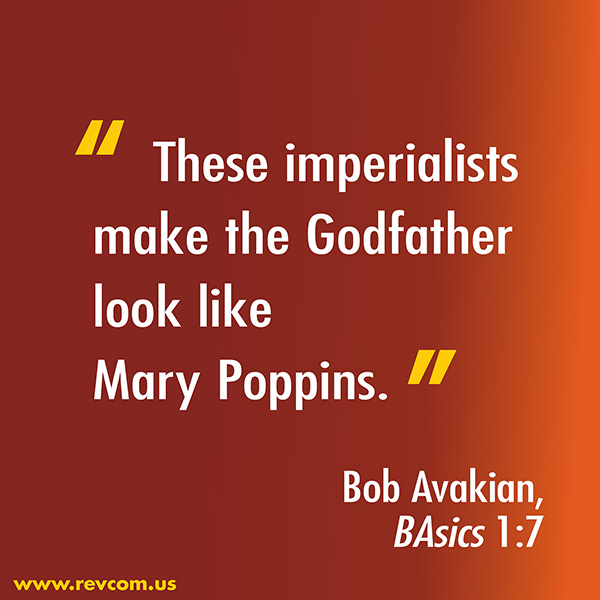Trump-Pence Regime Cancels Key Nuclear Arms Treaty with Russia
74 Years After Hiroshima and Nagasaki the Nuclear Nightmare Is Still with Us—and Escalating
| revcom.us
It’s been 74 years since the U.S. dropped the first and only atomic bombs ever used on Hiroshima and Nagasaki, Japan on August 6 and 9, 1945, incinerating those cities and killing over 200,000 people, and injuring hundreds of thousands more. America had ushered in the nuclear era and the nightmarish specter of global annihilation, which has haunted humanity ever since. In recent decades, this nuclear danger seemed to have receded, but now it’s coming back with a vengeance.
When Trump was running for president he demanded to know: if we have nuclear weapons, why can’t we use them? He’s repeatedly threatened to obliterate his adversaries. Just a few weeks ago, on July 23, Trump casually claimed he had plans for wiping Afghanistan “off the face of the earth” and winning the war in a week, but he wouldn’t use them because “I just don’t want to kill 10 million people.” This was a blatant threat of a nuclear holocaust, which was likely also directed against Iran, where U.S. sanctions and military aggression have raised the real danger of war.
Then, on August 2, the U.S. withdrew from the Intermediate Nuclear Forces (INF) agreement, signed 32 years ago between the U.S. and the Soviet Union banning all land based nuclear and non-nuclear missiles with short and medium ranges. (The Soviet Union broke apart in the early 1990s, but Russia—the dominant nation within it—remained bound by the treaty.) The U.S. is already planning to test new intermediate range missiles later this summer. (Intermediate range missiles can travel 620 to 3,400 miles. They are a prime military tool for regional domination.)
The U.S. claimed that this was in response to the Russians violating the treaty. In fact, geopolitical tensions are escalating between U.S. imperialism and Russian imperialism, and some sections of the U.S. ruling class, especially grouped around the Democratic Party, see Russia as the U.S.'s main rival. However, the main target of this withdrawal is China, which has been developing its capability and had never been part of the treaty in the first place. There is now a broad consensus among the U.S. rulers—the fascist Trump-Pence regime along with significant sections of the no-less imperialist Democrats—that China is their main threat, and have been increasingly uniting around a series of very aggressive moves toward China (right now concentrated in trade, economics, and computer capability).
The 1987 signing of this treaty was part of backing away from the precipice of a U.S.-Soviet nuclear war. Since then, the U.S. and other world powers have continued to develop their nuclear arsenals. Now, by ending the INF treaty, the Trump/Pence regime is seriously ratcheting up that nuclear arms race, and heightening the danger of nuclear war.
On this 74th anniversary of the U.S. nuclear bombing of Hiroshima and Nagasaki, as part of urging readers to confront this country’s actual history and the enormity of its crimes, we’re reposting this installment of the American Crime series originally published in 2016. It remains as timely as ever, including because today the world’s powers have thousands of nuclear weapons and any nuclear conflict would unleash death and destruction on a far greater scale than even Hiroshima and Nagasaki.
Case #97:
August 6 and 9, 1945—The Nuclear Incineration of Hiroshima and Nagasaki
May 23, 2016 | revcom.us
American Crime is a regular feature of revcom.us. Each installment will focus on one of the 100 worst crimes committed by the U.S. rulers—out of countless bloody crimes they have carried out against people around the world, from the founding of the U.S. to the present day.
THE CRIME: At 8:15 am, on August 6, 1945, a blazing, million-degree fireball suddenly appeared just above the Japanese city of Hiroshima, instantly killing, burning alive, or vaporizing tens of thousands. Firestorms engulfed the city. Shockwaves and winds over 1,000 miles an hour came next, shattering bodies and buildings, hurling men, women, and children through the air. Nearly all structures were destroyed over a mile from ground zero.
“There were red burned and bloated dead bodies piled up high, the corpses with the guts and the eyes popped out, lines of ghost-looking people with burned frizzled hair and burned skin hanging,” one survivor recalled, and “barely living survivors who were not able to save their own children or parents.” In one room, there were 20 young men whose eyes had melted in their sockets. Clouds of dust turned the morning into twilight; later, black rain fell.
The U.S. had just exploded the first nuclear bomb over the center of a city of 350,000. Thousands who survived the blast soon experienced fevers, diarrhea, vomiting, hair and skin loss—the death knell of radiation sickness. By the end of 1945, between 140,000 and 150,000 people, overwhelmingly civilians, had perished in Hiroshima. Hundreds of thousands more were wounded.
Later that day, President Harry Truman announced the bombing and threatened Japan: “If they do not now accept our terms [for immediate surrender] they may expect a rain of ruin from the air, the likes of which has never been seen on this earth.” Three days later, on August 9, the U.S. dropped an even more powerful nuclear bomb on Nagasaki, destroying the city and murdering another 70,000 people.
THE CRIMINALS: President Harry S. Truman, who ordered the attack; U.S. Secretary of War Henry Stimson, who oversaw the war effort, including the building of this "most terrifying weapon ever known in human history"; General Leslie Groves, in charge of building the bomb; and the military command responsible for the bombing.
THE ALIBI: Dropping a nuclear bomb on Japan was needed to quickly end the war, avoiding a U.S. invasion which Presidents Roosevelt and Truman claimed would cost a million American lives.
“I realize the tragic significance of the atomic bomb.... We have used it in order to shorten the agony of war, in order to save the lives of thousands and thousands of young Americans,” Truman stated after nuking Hiroshima and Nagasaki.
This alibi has been repeated by all presidents since: “What I think the president does appreciate is that President Truman made this decision for the right reasons,” said President Obama’s press secretary.
THE ACTUAL MOTIVE: Control of Japan and post-World War 2 global domination. The U.S. knew Japan would collapse without an invasion and was suing for peace weeks before Hiroshima and Nagasaki. On July 12, 1945, Truman admitted in his private diary that the U.S. had received a “telegram from [the] Jap Emperor asking for peace.”
But the U.S. rulers wanted to totally control post-war Japan, prevent the Soviet Union from gaining more ground in Japanese-held Manchuria and having more influence in the post-war setup—or “get in so much on the kill,” as one U.S. official put it. This meant terrorizing Japan into surrendering immediately. That’s why the U.S. incinerated Hiroshima and then Nagasaki. Japan surrendered on August 15, six days after the Nagasaki bombing. These were also warnings to any who might think about challenging America’s dominance of the postwar world, written in mounds of charred flesh and many tens of thousands of horribly disfigured survivors.
REPEAT OFFENDER: The U.S. has repeatedly considered and threatened the use of nuclear weapons to enforce its global dominance: In the 1950s, the U.S. planned for possible nuclear war with the Soviet Union, which they calculated would have killed 600 million; in 1958, 1973, and 1980 it put its forces on nuclear alert during Middle East crises in Iraq, Israel, and Iran; in 1969 President Richard Nixon threatened to nuke Vietnam; before the 2003 invasion of Iraq, the Pentagon secretly prepared for the possibility of using nuclear weapons; Obama has announced plans to spend over $1 trillion in the next 30 years on new nuclear weapons.

Mushroom cloud over Hiroshima.

Nagasaki mail carrier Sumiteru Taniguchi's back injuries, taken in January 1946, from the U.S. atomic bomb attack on August 9, 1945.

Get a free email subscription to revcom.us:


